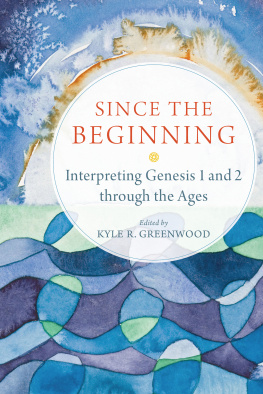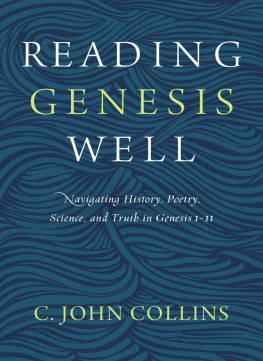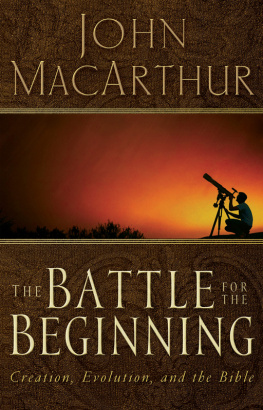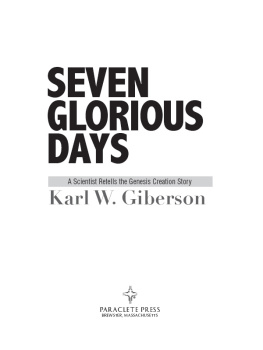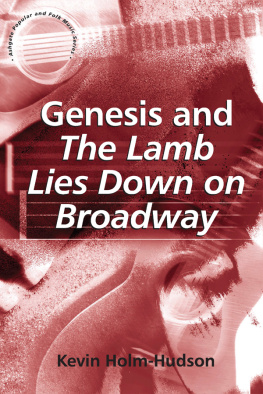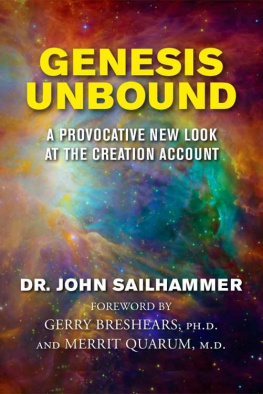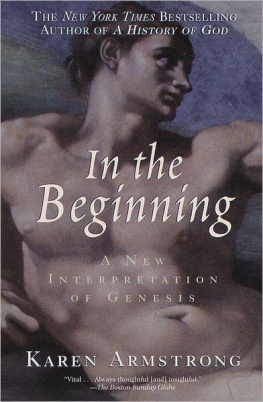Kyle R. Greenwood
1. Old Testament Reverberations of Genesis 12
Kyle R. Greenwood
2. Interpretations of Genesis 12 in Second Temple Jewish Literature
Michael D. Matlock
3. New Testament Appropriations of Genesis 12
4. Early Rabbinic Interpretations of Genesis 12
Joel S. Allen
5. Interpretations of Genesis 12 among the Ante-Nicene Fathers
Stephen O. Presley
6. Interpretations of Genesis 12 among the Nicene and Post-Nicene Fathers
C. Rebecca Rine
8. Medieval Christian Interpretations of Genesis 12
9. Interpretations of Genesis 12 among the Protestant Reformers
10. Rediscovery of the Ancient Near East and Its Implications for Genesis 12
David T. Tsumura
11. Post-Darwinian Interpretations of Genesis 12
Aaron T. Smith
Kyle R. Greenwood
Sidebars
1.1 Psalm 8
1.2 Ezekiel 28:1119
2.1 Jubilees 2.2
2.2 Philo, On the Creation of the World 1314
2.3 4QMiscellaneous Rules, 4Q265 frag. 7 II, 1117
2.4 Jubilees 3.812
3.1 Hebrews 4:911
3.2 John 1:15
3.3 2 Peter 3:57
3.4 Mark 10:69
3.5 Ephesians 5:2833
3.6 1 Corinthians 11:79
3.7 1 Corinthians 15:4549
3.8 Revelation 22:15
4.1 Genesis Rabbah 4:3
4.2 Genesis Rabbah 19:35
5.1 Theophilus of Antioch, Ad Autolycum 2.12
5.2 Origen, On First Principles 3.5.1
5.3 Irenaeus, Against Heresies 2.2.45
6.1 Chrysostom, Homily 8 in Homilies on Genesis
6.2 Basil, Homily 3 in Exegetic Homilies
6.3 Ephrem, Hymn 12 in Hymns on Paradise
6.5 Chrysostom, Homily 2 in Homilies on Genesis
7.1 Maimonides, Guide of the Perplexed 2.29
7.2 Maimonides, Guide of the Perplexed 2.25
8.1 Thomas Aquinas, Commentary on the Sentences
8.2 Meister Eckhart, Comments on Genesis 2:7
9.1 Martin Luther, Introduction to Genesis 1
9.2 John Calvin, Comments on Genesis 2:2
10.1 Enuma Elish on Creation and Marduk
10.2 The Epic of Atrahasis on the Creation of Human Beings
11.1 The Geological Record and the Days of Genesis 1
11.2 Source Criticism and Interpreting Genesis 1 and 2
Acknowledgments
The impetus for this book was a course I taught half a decade ago on the history of interpretation of Genesis 1. At the time there was no single volume of primary source texts and certainly no individual commentary available on these source texts to help undergraduate students make sense of the subject matter. I was out of my depth beyond the biblical material and realized in short order that a resource like the one here was very much in need. Needless to say, the book you are holding is a result of recognizing both my own deficiencies in the vernacular of the various interpreters and the need for the voices of these interpreters to have a broader audience.
Attempting to teach a course with only limited background in many of the periods up for discussion was a daunting, even foreboding, task. Though I had a deep interest in the subject and a profound understanding of the importance for the topic for the students, it took some encouragement from my former dean Sid Buzzell, as well as some kind words from my former colleagues Megan Devore, Johann Kim, Ryan Murphy, Aaron Smith, and Kevin Turner to garner the necessary courage to put the course on the schedule. They were also generous in directing me toward primary sources and providing me with helpful insights for constructing the course. The students in that section were stellar and also deserve mention: Jacob Balbas, Brooke Brundy, Ben Fisher, Taylor Gray, Neil Heitmann, Zack McMurren, Mandy Paleczny, and Jeremy Schmitz. Despite my inadequacies as their instructor, these students carefully read from the primary sources and through engaging and lively discussion arrived at a cogent understanding of the significance of the interpretive diversity through the ages. The questions pondered in the seminar were instrumental in helping me identify the four central themes addressed throughout the eleven chapters of this book.
It is also important for me to recognize and thank the ten contributors, some of whom I have known for years, while others I have only had the privilege of acquaintance through this project. Either way, I count each of them as friends. They have demonstrated charity with me as their editor, have been respectful of deadlines, and were generously patient with me when the project took some unforeseen detours. I could not have asked for a finer group of men and women with whom to collaborate, especially for my first effort as editor.
Jim Kinney has been a true professional as the chief editor at Baker Academic. When I pitched the idea of this book to him in a rather informal setting, he saw the potential in the project and helped craft the scope of the book and fine-tune its essential components. I should also add that James Ernestnow the vice president and editor-in-chief at Eerdmansplayed an important role in the early stages to help me establish a team of contributors.
Many other individuals have helped in multiple facets, large and small. Carl Pace and Ken Way graciously read early versions of my chapter. (Jeff Cooley and Chris Hays read such an early version of the chapter that it is no longer part of the book!) Unnamed countless othersfamily, friends, neighbors, church members, work colleagues, and studentshave asked penetrating questions, showed various levels of interest in the project, made seemingly innocuous remarks that have sparked new ideas, and have in many unseen ways contributed to the final product. I am grateful to each for their friendship, their wisdom, their interjections (and occasional objections), and their investment.

